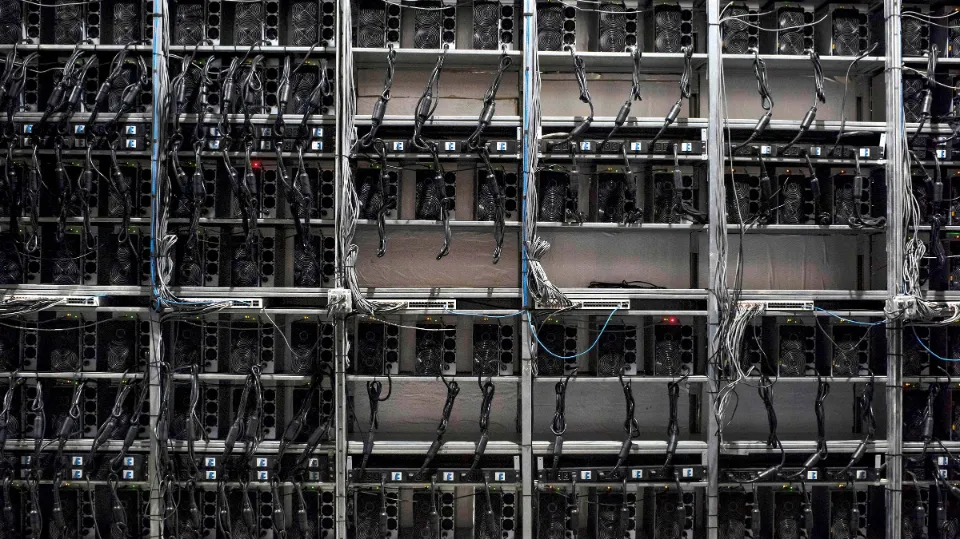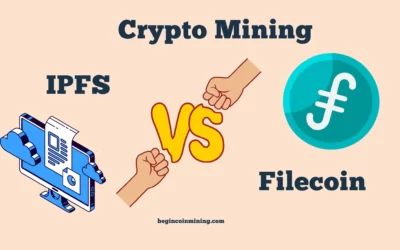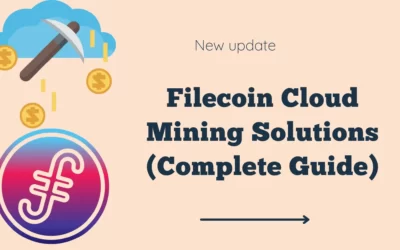Learn how to mine Filecoin in detailed guide, filecoin mining working principle, pros and cons to earn some extra money.
Simply adhere to the instructions on how to mine Filecoin, and you’ll soon be on your way to receiving Filecoin mining rewards:
- Choose a Filecoin miner group: storage miners, retrieval miners, Repair miners.
- Set a Filecoin mining rig: A Powerful CPU, Large Disc Space, Powerful RAM, A good Internet connection.
- Install Filecoin mining rig
- Start Mining Filecoin: Filecoin network uses three versions of consensus for mining: Proof-of-Replication (PoRep), Proof-of-Spacetime (PoSt), Proof-of-storage (PoSt).
- Set a Filecoin wallet to recieve rewards
We will walk you through the steps needed to get started filecoin mining. So, let’s get cracking.
What is Filecoin?
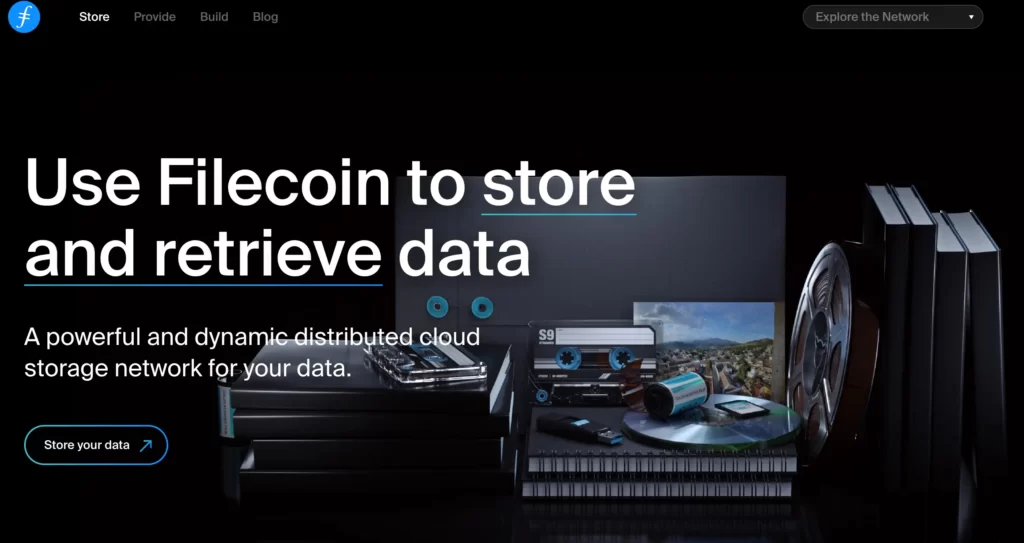
A network for open-source, decentralized file storage is called Filecoin. It is supported by IPFS, a peer-to-peer protocol created to make the internet faster, safer, and more equitable.
In other words, Filecoin’s blockchain is quite distinctive, just like Catgirl Coin. Filecoin, in contrast to other cryptocurrencies, adds an incentive layer to IPFS that compensates users for storing and sharing files.
The Filecoin network contains:
- Miners — responsible for storing data and maintaining the blockchain
- Storage providers — individuals or organizations that offer storage space on their computers or servers.
- Clients — users who upload files to the network.
Miners must give clients storage space and bandwidth in order to earn Filecoins. As compensation for their contributions, they receive Filecoins.
Leased storage space from storage providers generates File crypto for miners. Finally, customers pay miners or storage companies in Filecoins in exchange for having their data stored there.
The Filecoin network’s native cryptocurrency is called FIL (⨎).
How Does Filecoin Mining Work
Compared to mining Bitcoin and other cryptocurrencies, the Filecoin platform uses a different method. Instead of supplying computing power, Filecoin miners give users storage space to meet their needs for data storage. In other words, a Filecoin miner functions as a “database” in the Filecoin ecosystem.
The system is made to give miners a financial incentive to gather as much storage space as possible in order to rent it out to customers. The mining component of the system is directly linked to data storage and retrieval by the Filecoin protocol.
Three categories of FIL miners may be distinguished (although one group has not yet entered service):
Storage Miners
As storage service providers, these Filecoin miners keep client data. The quantity of storage they generate directly relates to their financial success. Large storage data is also needed for this.
Retrieval Miners
Filecoin is obtained by servers (also referred to as retrieval miners) who charge a fee for their services. How quickly and close they can provide service determines how much they are paid.
Repair Miners
In Filecoin mining, repair miners have not yet been used, but they are intended to take over when there is a miner that is unstable.
Once an agreement has been reached with a customer, storage providers or storage miners save the documentation of the data storage. The proof is open for anyone to examine and judge the validity of the miner.
However, retrieval miners or servers deliver client data when required (from clients or storage miners).
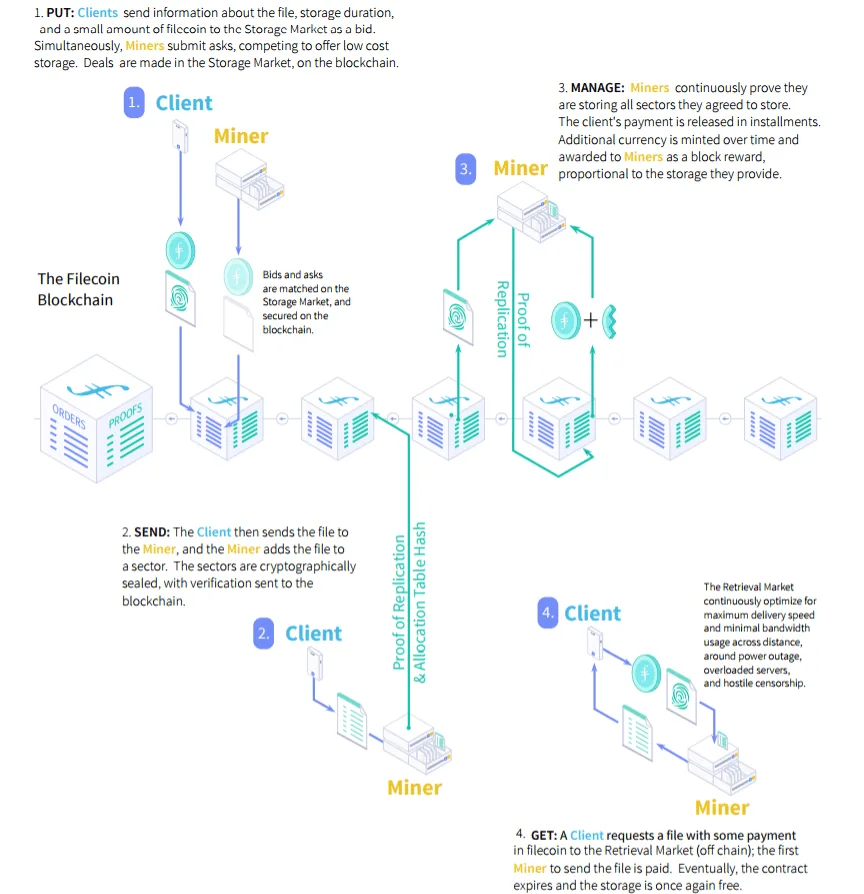
Advantages of Mining Filecoin
The advantage of mining bitcoins for money is obvious. In various circumstances, the financial gain might be sizeable. However, Proof-of-Stake mining aims to reduce environmental harm, which may eventually help to lessen that drawback.
Drawbacks of Mining Filecoin
The main drawback is that mining cryptocurrencies is expensive, both in terms of the hardware you need to purchase and the energy required to do it. Additionally, you might discover that the unstable market caused the value of the cryptocurrency to decline while you were mining.
How to Mine Filecoin (FIL)
In contrast to the traditional mining that underpins Bitcoin and other cryptocurrencies, the Filecoin platform uses a different method of mining.
Finally, the Filecoin network uses three versions of consensus for mining:
- Proof-of-Replication (PoRep)
- Proof-of-Spacetime (PoSt)
- Proof-of-storage (PoSt)
In Filecoin, miners contribute storage capacity rather than computational power to meet the needs of users/customers who want to store data. In other words, in the Filecoin ecosystem, miners work as “databases”.
In Filecoin they exist:
- 5 types of users that can trade Customers, miners, token holders, developers, and ecosystem partners all use FIL tokens.
- 3 types of markets: file storage, file retrieval and token exchange.
- 3 types of miners:
– Storage miners: earn Data storage for clients and the generation of cryptographic proofs to confirm storage over time are how the FIL token rewards users. In contrast to Bitcoin miners, Filecoin miners’ chances of collecting transaction fees and the per-block reward are based on the amount of storage they add to the network, not their hashing power.
– Retrieval miners: earn Depending on the size and market value of the file, mining fees and FIL tokens may be associated with it. The total number of transactions they can complete depends on their bandwidth and initial bid/ask times for deals.
– Repair miners: will be implemented in the future.
Each Filecoin miner has an associated power value on the network that is proportional to the amount of space contributed and determines the chances of earning the right to mine a block each epoch.
Filecoin Rewards Mechanism
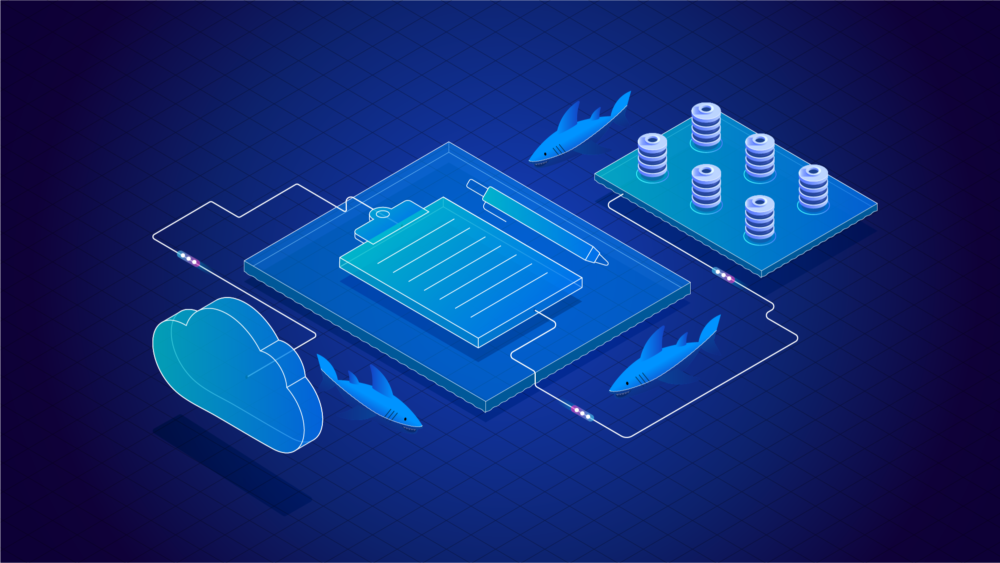
In the Filecoin network, miners receive a variety of rewards for their network-contributing efforts.
The two main types of rewards are:
Storage fees
Storage fees are the fees regularly paid by customers after an agreement is reached, in exchange for data storage and for miners sending regular storage proofs to the chain. These fees are automatically deposited into a miner’s associated wallet as they carry out their tasks and are momentarily blocked upon receipt.
PoSt (Proof-of-Spacetime) window checks are performed at 24-hour intervals across the network to ensure that miners continue to host their required sectors as normal. A miner will be compensated for the failure they committed for each day they are not idle.
Block rewards
By mining blocks, miners earn rewards and charge fees proportional to the amount of storage space contributed to the network.
The mechanism for obtaining the right to mine a new block is called WinningPoSt.
Unlike storage fees, these rewards do not come from an associated customer and it is the network that “prints” new As a means of inflation control and to reward miners who advance up the chain, FIL tokens are issued.
Each miner can earn the fees connected with each message contained in the block in addition to the block reward.
Verified customers
To incentivize data storage, storage miners also have the opportunity to compete for special offers provided by verified customers who need the miner to guarantee significant data storage.
Recovery fees
As recovery agreements are met, recovery fees are incrementally paid through the payment channels.
Penalties/Cuts
These are penalties that miners must pay if they do not provide reliability to the sector or decide to voluntarily leave the network. These include:
- Fault slashing fees: paid for each day that a miner’s sector is offline and does not send space-time evidence to the chain.
- Sector penalties: is a penalty incurred by a miner for a failed sector that was not declared failed before a There is a windowPoSt check.
- Termination fees are a penalty incurred by a miner when a sector is voluntarily or involuntarily cancelled and removed from the network.
Consensus failure reduction: is a penalty incurred by miners when they commit consensus failures and when they have acted maliciously against the consensus of the network.
Filecoin Mining Rig Requirements
To start mining, you will need the following:
- A Powerful CPU: a computer with a virtualization-capable processor and more than 8 cores, such as an AMD EPYC, Intel Xeon Scalable, or IBM Power9 processor. The mining software (Lotus, Slate) cannot operate without this. A good idea would also be the Intel SHA extension.
- Large Disc Space: At least 1 TiB of NVMe-based disk space must be available for cache storage. Additionally, for final storage, we advise getting a second hard drive. You can earn more Filecoin if you have more storage space. The network parameters total over 100 GiB, after all.
- Powerful RAM: 256 GiB of swap space and at least 128Gb of RAM are required.
- Efficient Internet Connection: an effective Internet connection.
- A Filecoin wallet. Filecoin will be kept in this location. Utilizing Coinbase or the official Trust Wallet app, you can create one.
How to Install a Filecoin Mining Rig
You must first download mining software in order to set up a Filecoin mining rig. Your swap size should be 250GB. To do this, go into your BIOS and change the “Advanced Memory Configurations.”
Then, save your modifications and restart your computer. Mounting your SATA drive is the next step that you must take. This hard drive will be used to store Filecoins.
To finish the filecoin mining rig installation:
- LAN users should set a fixed IP address.
- Change files limit.
- Configure your firewall to permit connections to Filecoin.
- Update Lotus and install the graphics card drivers from Nvidia.
- Create a wallet.
- Launch the Lotus storage miner.
- Put environment variables in place.
- the configurations for the miner.
- Execute Lotus-storage-miner. Add new storage.
- Launch the seal-working process by launching the seal worker.
Read More: Mining Rig: Buying or Building?
Filecoin Wallet
Filecoin wallets allow you to manage FIL, Filecoin’s native token. Wallets store the private keys that allow you to authorize Filecoin transactions, including paying for storage deals and sending FIL to other accounts.
The below lists the recommended wallet implementations:
- Glif Wallet: Glif Wallet is a lightweight web interface to send and receive Filecoin with a Ledger device (instructions).
- Glif Safe: Glif Safe is a multisig wallet with a lightweight web interface to send and receive Filecoin with a Ledger device (instructions). Check out the Glif Safe GitHub repo for more information.
- Lotus: Lotus includes a command-line wallet that can manage bls, sec1p256k1, multisig wallets, and supports Ledger integration.
Glif Safe and Lotus both support multisig wallets, a multisig wallet is a wallet that requires two or more private keys in order to sign and send transactions. Multisig wallets prevent any one private key holder from signing and sending a transaction, this is beneficial for wallets with multiple users and for people who are concerned about an attack on their wallet.
Lotus, Glif Safe, and Glif Wallet all support Ledger hardware devices, allowing you to use Filecoin without storing your private keys on a network-connected device. This can help protect your valuable private keys from malicious software on your computer and is commonly used for accounts with large balances.
There are a number of additional wallets that support Filecoin tokens, including mobile wallets.
Conclusion: Start to Mine Filecoin
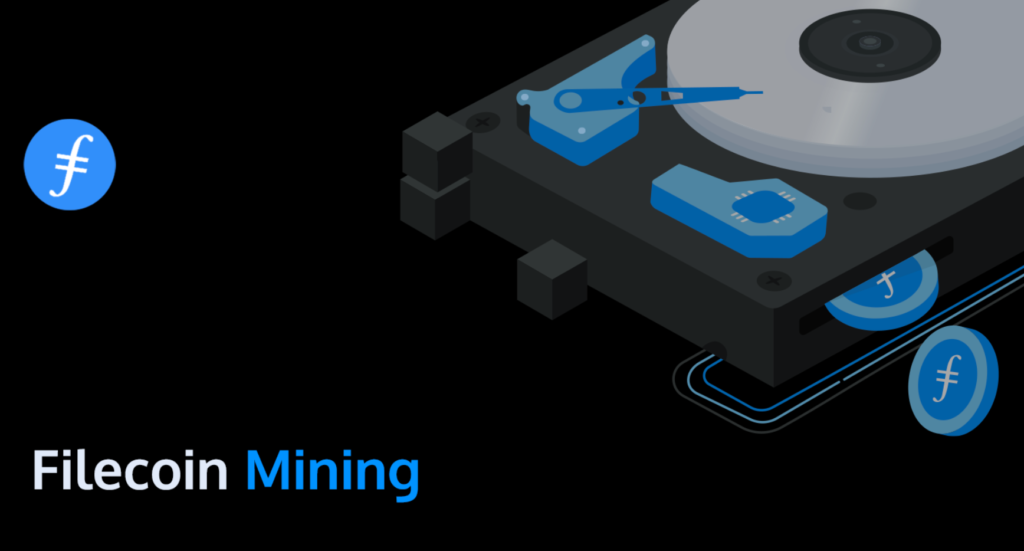
The Filecoin mining method is labor-intensive, but it is possible with a powerful computer.
If you have a good computer, you can definitely complete the somewhat complicated Filecoin mining process. All you have to do to start receiving Filecoin rewards is to follow the instructions we provided.
- Choose from the storage, retrieval, or repair Filecoin miner groups.
- Set up a filecoin mining rig with a strong CPU, plenty of disk space, strong RAM, and a reliable internet connection.
- Install Filecoin mining rig
- Start Mining Filecoin: The Filecoin network uses the Proof-of-Replication (PoRep), Proof-of-Spacetime (PoSt), and Proof-of-storage (PoSt) consensus models for mining.
- Set a Filecoin wallet to recieve rewards
This is a friendly suggestion, not financial advice. Do your own research, put time into it, and don’t rush to get what you need.
Filecoin Mining FAQs
What is Needed to Mine Filecoin?
A good computer with a powerful processor, i.e., more than 8 cores, at least 50 128GB of RAM is required, as well as GB of free space. The mining software for Filecoin (like Lotus or Slate) must then be downloaded.
Your computer’s CPU or GPU will be used by the mining software to mine for Filecoin. You can receive benefits so long as the mining program is active.
Where to Buy Filecoin
There are several methods you can use if you want to purchase Filecoins. The simplest way is to purchase it from an exchange. Currently, the most popular exchanges that support Filecoin are: Binance, Kraken, Coinbase.
Is Mining Filecoin Profitable?
It can be, but how profitable it is will depend on many things, like the price of Filecoin, which is currently $7.63, how much storage space you have, and how much CPU or GPU power you are willing to use for mining.
In general, mining will be more profitable if you have more storage space and a more powerful computer.
How Long Does It Take to Mine Filecoin?
One Filecoin can be mined in one to five hours. Your computer’s processing power and the size of the mining pool you are a part of will both affect speed.
How Do I Create a Filecoin?
A Filecoin can be produced by mining for it. You give the network storage space when you mine for Filecoin. Filecoin will be awarded to you in exchange for your contribution.
Storage, retrieval, and repair miners are the three different categories of miners, as was previously stated. By giving the network storage and keeping client data safe, storage providers earn Filecoin. Retrieval miners, on the other hand, hold off on offering the service until there is a need.
Therefore, before starting to learn how to mine Filecoin, you must choose whether you want to be a storage miner or a retrieval miner.







